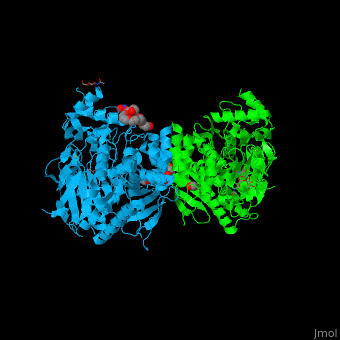Human Acetylcholinesterase
From Proteopedia
(Difference between revisions)
| Line 1: | Line 1: | ||
<StructureSection load='4ey4' size='450' side='right' scene='49/497015/Cv/1' caption=''> | <StructureSection load='4ey4' size='450' side='right' scene='49/497015/Cv/1' caption=''> | ||
| - | |||
The human acetylcholinesterase (AChE) is an enzyme which hydrolyses the neurotransmitter Acethylcholin (ACh) in the neuromuscular junctions and in other cholinergic synapses to terminate the neuronal signal. | The human acetylcholinesterase (AChE) is an enzyme which hydrolyses the neurotransmitter Acethylcholin (ACh) in the neuromuscular junctions and in other cholinergic synapses to terminate the neuronal signal. | ||
It has an ellipsoidal shape with dimensions ~ 4,5nm x 6nm x 6,5nm. This protein is composed of 531 residues. It consists of 12-stranded, central mixed <scene name='49/497015/Cv/2'>β-sheet</scene> surrounded by 14 <scene name='49/497015/Cv/3'>α helices</scene>. | It has an ellipsoidal shape with dimensions ~ 4,5nm x 6nm x 6,5nm. This protein is composed of 531 residues. It consists of 12-stranded, central mixed <scene name='49/497015/Cv/2'>β-sheet</scene> surrounded by 14 <scene name='49/497015/Cv/3'>α helices</scene>. | ||
| Line 15: | Line 14: | ||
The catalytic site of AChE consists of two subsites: the "esteratic" site and "the anionic" site. | The catalytic site of AChE consists of two subsites: the "esteratic" site and "the anionic" site. | ||
| - | In the "esteratic site" a catalytic triad consisting of <scene name=' | + | In the "esteratic site" a catalytic triad consisting of <scene name='49/497015/Cv/6'>E334, H447, S203</scene> forms a planar array that resembles the catalytic triad of serine proteases. |
S203 is activated (it becomes nucleophilic) by E334 and H447. This activation allows the following reaction: the acylation between hydroxyl group of S203 and ACh oxygen (or other agonists). A covalent bond between the enzyme and the substrate creates an oxyanion. This oxyanion then reacts with two glycins setting up a hydrogen bond. | S203 is activated (it becomes nucleophilic) by E334 and H447. This activation allows the following reaction: the acylation between hydroxyl group of S203 and ACh oxygen (or other agonists). A covalent bond between the enzyme and the substrate creates an oxyanion. This oxyanion then reacts with two glycins setting up a hydrogen bond. | ||
| - | In the "anionic" site, the <scene name=' | + | In the "anionic" site, the <scene name='49/497015/Cv/5'>W86</scene> binds trimethylammonium group of ACh. |
Further to these steps the substrate is well positioned to be hydrolysed into acetic acid and cholin. | Further to these steps the substrate is well positioned to be hydrolysed into acetic acid and cholin. | ||
Revision as of 13:32, 16 January 2018
| |||||||||||



